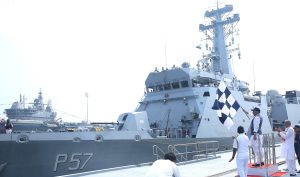An Indian Navy Offshore Patrol Vessel (NOPV), INS Sunayna, was flagged off from Karwar naval base on a mission of multinational cooperation on April 5 by Defense Minister Rajnath Singh.
INS Sunayna has been renamed Indian Ocean Ship (IOS) Sagar — an acronym for Security and Growth for All in the Region. On board with the crew are 44 naval trainees from nine Friendly Foreign Nations (FFNs): Comoros, Kenya, Madagascar, Maldives, Mauritius, Mozambique, Seychelles, Sri Lanka, and Tanzania.
The Sagar initiative is a significant step in operationalizing India’s commitment to regional maritime security. The Indian Navy takes pride in functioning as the “preferred security partner” in the northern Indian Ocean. Over the years, this has involved policing the “international sea lines of communication” (SLOCs) that run through these waters, functioning as “gatekeeper of the global commons” and enforcing “freedom of navigation and overflight” in the vast maritime area between the Gulf of Aden and the Strait of Malacca.
India’s leadership in the security matrix of the Indian Ocean Region (IOR) began in December 2004, when the Indian Navy’s lightning-quick response to the Indian Ocean tsunami made the United States Pacific Command and the Pentagon realize that here was a regional partner worth having. India’s comprehensive humanitarian aid and disaster relief (HADR) program saved tens of thousands of lives across the Indian Ocean littorals. It was quickly followed by the renewal of the Defense Framework Agreement of 2005, and a growing strategic cooperation that led directly to the India-U.S. Civil Nuclear Agreement. From there, it was but a short hop to India’s designation as a Major Defense Partner in 2016 and the inking of three “foundational defense agreements” shortly thereafter.
But there is growing concern today that the relationship might be stalling. There is a tacit understanding that India will buy U.S. weaponry and that the two militaries will continue to exercise together, but there is little beyond that. India’s purchase of high-tech defense equipment from the United States is running out of steam, evident from the difficulties faced by U.S. engine-maker General Electric in supplying and co-manufacturing fighter aircraft engines for India’s combat aircraft program.
In this context, the voyage of IOS Sagar is significant, as it brings together multiple maritime agencies of the Southwest IOR for joint training on an Indian naval platform. It also brings together trainees from the FFNs – designated as “sea riders” – who will collaborate on a maritime security mission.
“Along with other stakeholders, the Indian Navy is ensuring peace and prosperity in the region. Equipped with state-of-the-art ships, weapons and equipment and well-trained and motivated sailors, we resolve to move ahead with other friendly nations towards developing IOR as a symbol of brotherhood and shared interest,” Singh, the defense minister, said.
The Indian Navy maintains a careful watch over these waters and the cargo ships that sail through them, carrying one-third of the world’s bulk cargo and an even higher percentage of hydrocarbon exports.
In Gurgaon, near New Delhi, a thousand miles from India’s coast, the navy has established a high-tech monitoring establishment called the Information Management and Analysis Center (IMAC). The IMAC obtains feeds from multiple space-based and terrestrial sensors, to track fishing boats and commercial vessels near India’s coast and in the vast maritime domain beyond.
Working alongside IMAC in Gurgaon is a multinational agency called the Information Fusion Center for the Indian Ocean Region (IFC-IOR). Both these agencies are charged with keeping India’s waters safe. The IFC-IOR was conceived by the government of India in March 2012, and operationalized in November 2014, just two-and-a-half years later. Its thrust remains on tracking civilian, commercial shipping.
The Indian Navy, meanwhile, has a separate “Operations Room” that tracks its own and hostile warships. While monitoring duties and control room functioning are distributed between IMAC and IFC-IOR, there is a deliberate firewall between the two.
The IMAC (and, therefore, the IFC-IOR) obtains inputs from a range of sensors. Primary inputs come from India’s coastal radar network that is manned by the Coast Guard. At the broader, international level, India has White Shipping Agreements with 36 countries and three multinational agencies. This feeds in details of all commercial shipping passing through their ports.
The IMAC also incorporates inputs from LRIT (long range identification and tracking). This mechanism, which works under the International Maritime Organization, paves the way for 174 countries to provide real-time information on their commercial shipping.
During its deployment, INS Sunayna (IOS Sagar) will visit Dar-es-Salaam, Nacala, Port Louis, and Port Victoria. The international crew aboard will undertake training exercises and apply knowledge gained from various professional training schools at Kochi.
The exercises/training planned to be carried out on IOS Sagar include firefighting, damage control, Visit Board Search and Seizure (VBSS) operations, bridge operations, seamanship, engine room management, switchboard operations, and boat handling — all of which will improve interoperability between the Indian Navy and its international partners.
“The Indian Navy ensures that no nation in the IOR suppresses another on the basis of overwhelming economy and military power,” Singh said in a thinly-masked reference to the Chinese military. “Our aim is to develop IOR as a symbol of brotherhood and shared interest.”
The activities planned for IOS Sagar will play a crucial role in shaping the future of the IOR. With this mission, India once again reaffirms its commitment to building stronger ties with its maritime neighbors and working towards a safer, more inclusive and secure maritime environment in the IOR.
Singh highlighted the historical significance of April 5, when India’s first merchant ship, SS Loyalty, sailed from Mumbai to London in 1919.
Describing it as a propitious occasion to launch the IOS Sagar mission, Rajnath said: “It’s a proud moment to see India leading the charge for regional cooperation on the same date that we mark our maritime legacy.”
































